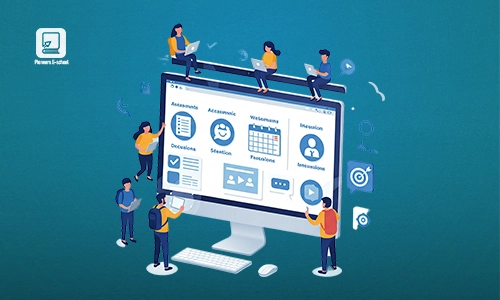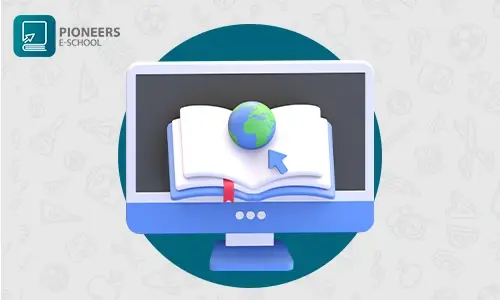Modern technology and the internet are among the most important factors that are causing a radical transformation in education worldwide. E-learning is characterized by flexibility and infinite learning possibilities. Thanks to the increasing use of the internet and technology in education, online learning allows for easy access to modern and diverse educational resources, in addition to saving time and costs associated with traditional learning.
Global statistics indicate that the demand for e-learning is constantly increasing. It is expected that the number of e-learning users worldwide will reach 325 million by 2025. At the same time, hundreds of universities and educational institutions are working to provide e-learning platforms and modern educational content online to help students achieve their educational goals.
However, online learning also faces some challenges and problems, including difficulties in direct interaction between students and teachers, lack of focus and attention in some cases, and excessive reliance on technology in education. In this article, we will explain the most important pros and cons of e-learning, as well as the latest trends in education.
Statistics on the Development of Online Education
There are many statistics that demonstrate the development of remote education worldwide, including:
- According to a report by HolonIQ, the e-learning market is expected to reach a volume of $350 billion by 2025.
- Research and Markets report indicates that in 2020, e-learning was adopted by 90% of companies worldwide.
- According to a report by Class Central, the number of users of various e-learning platforms reached 300 million in 2020, reflecting a 10% increase from the previous year.
- According to a report by Coursera, more than 6 million students enrolled in online courses offered by the platform in 2020.
- According to a report by Udemy, the number of registered students in distance learning courses offered by the platform increased by 425% from 2015 to 2020.
- A report by UNESCO indicates that more than 1.2 billion students worldwide were affected by the COVID-19 pandemic, leading many educational institutions to switch to online learning.
- A report by Gartner shows that the percentage of organizations using remote learning technologies in employee training has increased by 64% over the past four years.
Advantages of Online Education:
- Flexibility in learning
Online education allows learners to organize their schedules and timetables flexibly according to their personal circumstances. This means that learners can benefit from lessons and educational materials at any time that suits them, without the need to be present in a specific location at a certain time.
One of the most important reasons that makes flexibility in learning an important advantage in online education is that individuals have different interests and personal circumstances, and their schedules may not be compatible with traditional education schedules.
Therefore, online education provides the flexibility that allows learners to allocate learning time according to their personal circumstances and other responsibilities, which helps them improve their efficiency and the quality of their learning experience.
- Access to online education by anyone with an internet connection
In 2021, more than 20 million new users registered on the Coursera platform, and the total number of users on the platform reached 92 million users! Since online courses are available to almost everyone, this has greatly contributed to reducing the global education gap.
Online classrooms make learning available to people with disabilities or cognitive delays. For example, deaf students can simply turn on the closed captioning (CC) feature to read the conversation and participate in the class online. Many platforms support video conferencing and learning management systems to increase participation in online classes.
- Obtaining More Opportunities
Online education helps provide more opportunities for individuals around the world, including those living in remote areas or those who cannot access traditional education due to social or economic circumstances. With online education, students can obtain certificates and university degrees online, which can help them get better job opportunities.
Additionally, online education allows individuals to develop skills in different fields, making them more qualified for the job market and giving them wider opportunities to advance in their careers. Thanks to distance learning technologies, people can also improve their educational levels and learn new skills without the need to be present at a specific location or follow a set timetable.
- Saving Money
Online learning eliminates the need to travel or commute to a campus, which means saving money on transportation and accommodation in the campus. Also, the cost of studying online is less than that offered by traditional universities.
This is mainly due to the fact that online universities have lower administrative costs and provide courses digitally, which means saving money on paper materials and textbooks. There are also many free online resources such as open free courses and educational channels on YouTube. This means saving money on buying textbooks and private lessons.
- Connecting at a Global Level
Online educational courses enable connecting with teachers and colleagues from all over the world. Before widespread online education was available, you had to travel from one country to another to gain knowledge. Now, you can join a European university and obtain a certified degree from your home.
Also, online learning allows you to communicate with people from different backgrounds and cultures. This can add a different perspective and give you additional experience in communication.
- Encourages independence and self-reliance
Many online courses offer students the option to study at their own pace. This can alleviate the anxiety that students may feel about not having enough time in their busy lives to attend classes regularly every week. Courses that allow students to progress at their own rate are ideal for busy schedules. However, it requires a great deal of self-discipline to successfully complete these courses.
If students find that they lack self-discipline and cannot complete courses that allow them to progress at their own pace, there are online courses that group students together with specific deadlines. This is a great option for students and teachers who benefit from a more traditional classroom structure. Teachers who follow this model often use the modular approach, which is an effective learning approach by releasing content gradually.
- Improves tracking and continuity
If you struggle with organization or have difficulty remembering what you learned last week, online lessons can help. Most online classroom systems keep a record of what you have already read and the resources you have accessed, and guide you to the next steps you need to take. Your tasks are automatically saved, your grades are tracked, and your cumulative success rate is calculated so far. In comparison, learning through an actual classroom requires managing a lot of heavy papers, books, and physical equipment.
Online classrooms also allow for virtual labs to be launched, making interactive learning sessions easy. Tests and surveys can also be launched through the learning management system by the teacher, and you can see your results almost instantly.
Disadvantages of Online Education:
- Health Problems
Online education typically requires long hours sitting in front of a computer or mobile device, and staring at digital screens all day can lead to negative effects such as eye strain, sleep disruption, headaches, neck and back pain.
Therefore, learners studying online must take measures to avoid these symptoms, such as using blue light glasses, taking breaks every 20 minutes to look at something different, changing their work environment, avoiding overly bright screens, and reducing the contrast on their screens.
- Heavy reliance on technology
Online learning requires the intensive use of technology, and therefore, it is greatly affected by technical glitches, internet connectivity issues, and software errors. This may result in delays in submitting coursework and disrupt the learning process.
- Lesser opportunity to communicate with peers
Although online classes can be social in nature, the opportunity to communicate with peers is often less. In most cases, classes are completed alone, which can be a major drawback, especially for students who spend long hours alone at home.
However, students can combat feelings of isolation by working on their online courses in cafes or libraries where a more lively environment is available. Additionally, students can join courses with active online communities to virtually connect with other students.
- E-learning requires strong skills in self-motivation and time management.
The lack of self-motivation among students is still one of the main reasons for their failure to complete online courses. In traditional classrooms, there are many factors that constantly drive students towards their educational goals.
- Lack of practical experience.
Some subjects may be more suitable for online learning than others, for example, learning mathematics or biology online is relatively easier as it involves a lot of visual or auditory explanations.
However, learning things like medical examination, dentistry, or even pottery or other crafts can be difficult because of the practical aspects that require hands-on application to improve the skill. Therefore, it may be better for kinesthetic learners to resort to in-person learning or purchase the training equipment they will need to learn the new skill themselves at home.
Read also:
The top 6 Pros and Cons for online learning
Conclusion
After studying the advantages and disadvantages of online learning, it can be concluded that there are both positive and negative aspects to this type of education. On the positive side, online learning allows students flexibility and comfort in their studies, in addition to easy access to educational resources. It also helps to develop academic achievement and time management skills.
On the other hand, online learning can be a solitary and non-social experience, which can lead to feelings of isolation and loneliness. Additionally, online learning requires a lot of self-discipline and individual responsibility, which can be a challenge for students who need more support and guidance.
Overall, online learning is a good choice for students who need flexibility and comfort while studying, but it may not be suitable for everyone. Therefore, it is important to make sure whether online learning is the best option for you before enrolling in online educational courses.
Related Articles

2023-04-05
Amgad Hassanain
Top 6 advantages and disadvantages of online learning
Online learning (or distance learning) is one of the most widespread trends in the education field in recent years. This spread is attributed to the t...

2025-01-21
Mohamed Abdelsalam
How Do Student Portals Enhance Student Engagement in School Management Systems?
In today’s digital age, schools are increasingly turning to technology to enhance the learning experience and streamline administrative processe...

2024-01-24
Mohamed Abdelsalam
comprehensive guide use of technology in education
Technology is a set of tools and means that help a person improve his life and facilitate his work. Among the areas of use of technology, education is...





